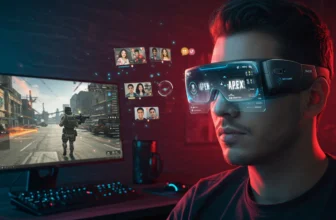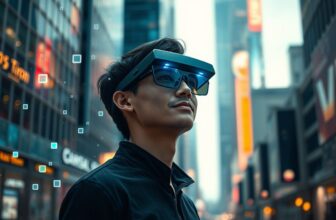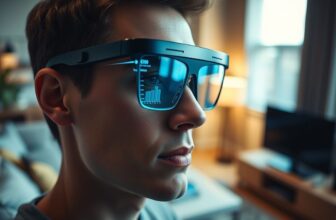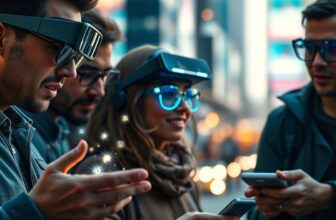As the market for advanced eyewear reaches $31.02 billion, the differentiation between Augmented Reality and Mixed Reality glasses is gaining much more significance for both consumers and enterprises. This detailed guide explores the basic differences between these transformational technologies and helps you make an informed decision on which solution best suits your needs.
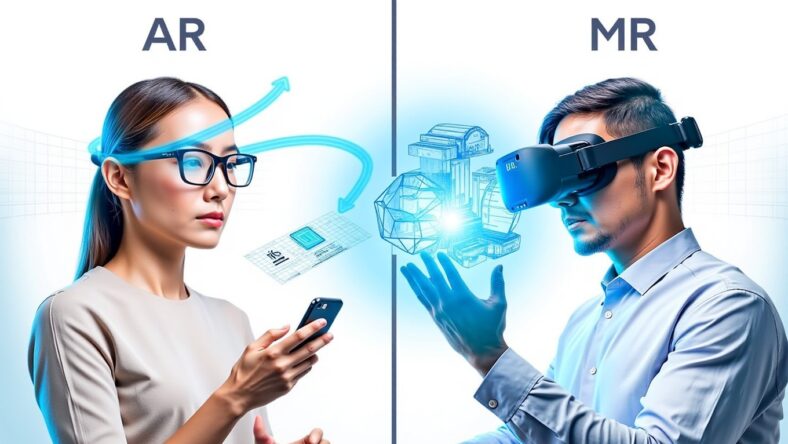
Understanding Core Technologies
Whereas there’s a core difference between the AR and MR themselves in the way they unite the virtual content with the physical, there is a huge difference. While AR glasses overlay information from the digital world onto the real world view, MR glasses create a more complex merge in which digital objects can interact with and respond to the physical environment.
MR glasses create a more complex merge in which digital objects can interact with and respond to the physical environment.
Technical Differences between AR and MR Glasses: Hardware Comparison
The technical architecture in the headset of augmented and mixed reality introduces one of the basic divergences in the way the headset processes and presents information of digital origin. Each of these is an element that needs to be related to development, appreciation, and capability that these would have in performing the functionality of spatial computing.
Display and Visual Systems
While display technology is a cornerstone in both AR and MR glasses, the philosophy behind the visual presentation of each medium really differs. Most AR glasses use an optical see-through display, superimposing digital information onto the natural field of view of the user. Those systems typically project images either via waveguide optics or beam splitters and result in a see-through display to let users maintain awareness of their surroundings while viewing digital information.
In contrast, MR glasses utilize more sophisticated holographic displays that enable a deeper integration between virtual and physical elements. These displays typically offer higher resolution and better color reproduction compared to their AR counterparts. The Microsoft HoloLens 2, for example, employs advanced waveguide technology capable of displaying up to 2.5K radiants per eye, creating more convincing holographic objects that appear to exist within the physical space.
Field of view (FOV) represents another crucial distinction between these technologies. Traditional AR glasses often provide a relatively limited FOV, typically ranging from 30 to 52 degrees diagonal. MR devices, designed for more immersive computing experiences, generally offer wider fields of view, with newer models approaching 90 degrees diagonal. This expanded FOV allows for a more natural integration of virtual objects into the user’s peripheral vision, enhancing the overall sense of presence and real-world integration.
Environmental Mapping Features
Environmental mapping capabilities mark a significant divergence between AR and MR glasses. AR devices primarily focus on basic surface detection and simple spatial awareness, enabling digital overlay of information onto flat surfaces or predetermined markers. These systems typically employ basic sensors and cameras to track the user’s position and orientation relative to their environment.
MR glasses, however, incorporate more sophisticated environmental mapping systems that create detailed three-dimensional models of the surrounding space. These devices utilize multiple sensors, including depth cameras and infrared projectors, to generate real-time spatial meshes. This advanced mapping enables virtual object interaction that respects physical boundaries and allows digital elements to occlude behind real objects, creating a more convincing blend of virtual and physical realities.
The sophistication of MR mapping systems also facilitates persistent spatial anchors, allowing digital content to maintain fixed positions in physical space across multiple sessions. This capability proves particularly valuable in enterprise AR solutions, where consistent placement of virtual interfaces and information is crucial for workplace efficiency.
MR’s advanced mapping enables virtual object interaction that respects physical boundaries and allows digital elements to occlude behind real objects.
Processing Power: AR vs MR Glasses Compared
The computational demands of AR and MR glasses reflect their distinct approaches to wearable technology. AR glasses typically require less processing power, as they primarily handle simple digital overlays and basic environmental tracking. These devices often utilize mobile-grade processors and can sometimes offload processing to connected smartphones, making them more suitable for extended use in consumer applications.
MR devices, however, demand significantly more processing capability to deliver their enhanced spatial computing features. These systems must simultaneously handle complex environmental mapping, advanced gesture recognition, and sophisticated physics simulations for virtual object interactions. The processing requirements often necessitate more powerful onboard computers, which can impact device size and battery life. For instance, leading MR devices incorporate custom holographic processing units (HPUs) specifically designed to handle the complex calculations required for convincing mixed reality experiences.
The distinction in processing capabilities directly influences the devices’ ability to handle complex applications and their potential for future feature expansion through software updates. MR glasses typically offer more room for advanced applications and future digital transformation initiatives.
Spatial Recognition Capabilities
Depth sensing capabilities represent perhaps the most crucial technical distinction between AR and MR glasses. AR devices typically employ basic depth sensors primarily used for hand tracking and simple gesture recognition. These systems can detect basic spatial relationships but may struggle with complex environmental interactions.
MR glasses incorporate more advanced depth sensing arrays, often combining multiple sensor types to create comprehensive spatial understanding. These systems can accurately measure distances, detect complex surface geometries, and track multiple moving objects simultaneously. This enhanced spatial awareness enables more sophisticated interactions between virtual and physical elements, such as virtual balls bouncing realistically off real surfaces or digital characters navigating around physical obstacles.
The superior depth sensing in MR devices also enables more natural interaction models. While AR glasses often rely on simple gesture commands or external controllers, MR systems can track precise finger movements and hand positions, allowing users to manipulate virtual objects with natural gestures. This capability proves particularly valuable in professional applications, such as virtual product design or training simulations.
User Experience and Controls
The way users interact with AR and MR glasses fundamentally shapes their utility and adoption in both consumer and enterprise environments. Understanding these interaction paradigms is crucial for appreciating how these technologies integrate into daily workflows and activities.
Input Methods
AR glasses typically employ straightforward input methods that prioritize simplicity and reliability over complexity. Most AR systems utilize a combination of voice commands, basic gesture recognition, and physical controllers. For instance, popular AR headsets like the Google Glass Enterprise Edition 2 primarily rely on a touch-sensitive side panel and voice commands, making them suitable for hands-free operations in industrial settings.
These control systems often integrate with existing mobile device interfaces, allowing users to manage their AR experience through companion smartphone applications. This approach reduces the learning curve and leverages users’ familiarity with traditional mobile interfaces. However, this simplicity can sometimes limit the depth of possible interactions, particularly in more complex use cases requiring precise manipulation of digital content.
Mixed reality devices, conversely, implement more sophisticated input methods that enable natural interaction with virtual objects. Advanced gesture recognition systems track individual finger movements and hand positions in three-dimensional space, allowing users to grab, rotate, and manipulate virtual objects as they would physical ones. The Microsoft HoloLens 2, for example, can track up to 25 points of articulation per hand, enabling precise gesture control and natural interaction patterns.
Immersion Levels
The immersive qualities of AR and MR glasses represent a significant divergence in user experience. AR glasses typically provide an information overlay experience, where digital content appears as a distinct layer superimposed on the user’s view of the physical world. This approach maintains a clear separation between digital and physical elements, which can be beneficial in scenarios requiring constant awareness of the real environment, such as industrial maintenance or medical procedures.
MR glasses achieve a deeper level of immersion by creating a more seamless blend between virtual and physical elements. Through advanced spatial computing and environmental mapping, MR devices can generate digital objects that appear to occupy physical space convincingly. These objects can cast shadows, be occluded by real objects, and respond to physical lighting conditions, creating a more compelling sense of presence.
The distinction in immersion levels significantly impacts user engagement and application possibilities. While AR’s lighter immersion suits task-oriented scenarios requiring quick information access, MR’s deeper immersion enables more complex applications like architectural visualization or medical training simulations, where realistic interaction with virtual objects is crucial.
Real-world Integration Differences
The integration of digital content with the physical environment varies significantly between AR and MR systems. AR glasses typically provide contextual overlays that respond to basic environmental cues, such as displaying navigation arrows that follow streets or showing product information when scanning items. This level of integration suffices for many practical applications but maintains a clear distinction between digital and physical elements.
MR devices achieve more sophisticated real-world integration through advanced spatial awareness and environmental understanding. These systems can recognize complex surface geometries, track multiple moving objects, and understand spatial relationships between physical elements. This enhanced integration enables applications where virtual objects interact naturally with the physical environment, such as virtual furniture that accurately fits into real rooms or digital characters that navigate around physical obstacles.
The quality of real-world integration directly impacts the range of possible applications and the naturalness of the user experience. MR’s superior integration capabilities make it particularly valuable in professional design and collaboration scenarios, where accurate spatial relationships between virtual and physical elements are essential.
Interface Design: AR vs MR Glasses Approaches
AR glasses typically employ traditional two-dimensional interface elements adapted for spatial display. These interfaces often resemble mobile app interfaces projected into the user’s field of view, utilizing familiar elements like menus, buttons, and scroll lists. This approach leverages users’ existing mental models of digital interfaces while adapting them for hands-free operation.
MR systems pioneer more innovative interface paradigms that take full advantage of three-dimensional space. Rather than simply projecting 2D interfaces, MR applications can create spatial user interfaces where menus and controls exist as manipulatable objects in 3D space. This approach enables more intuitive interaction patterns, such as grabbing and moving interface elements directly or using physical surfaces as virtual workspaces.
The evolution of these interface design approaches continues to be driven by user research and technological advancement. While AR interfaces prioritize clarity and efficiency in information delivery, MR interfaces explore new paradigms that blur the line between interface and content, creating more natural and intuitive interaction models.
The distinction in user experience and interaction models between AR and MR glasses reflects their different approaches to merging digital and physical realities. While AR systems excel in providing accessible, task-oriented experiences with minimal learning curve, MR devices offer more sophisticated interaction possibilities at the cost of greater complexity. Understanding these differences is crucial for selecting the appropriate technology for specific use cases and user requirements.
Practical Differences Between AR and MR Glasses in Real-World Use
The practical applications of AR and MR glasses demonstrate their distinct capabilities and highlight how different industries leverage these technologies for specific use cases. Understanding these real-world implementations helps organizations make informed decisions about which technology best suits their needs.
Enterprise Usage: AR vs MR Glasses Compared
In the enterprise sector, AR and MR glasses have revolutionized numerous operational processes through different approaches to spatial computing and digital transformation. Manufacturing facilities have widely adopted AR solutions for assembly line operations, where workers benefit from hands-free access to technical documentation and real-time guidance. According to recent industry reports, companies implementing enterprise AR solutions have observed productivity improvements of up to 40% in assembly tasks.
Mixed reality technology offers more sophisticated applications in industrial settings, particularly in complex maintenance and repair scenarios. For instance, aerospace manufacturers utilize MR devices with advanced environmental mapping capabilities to guide technicians through intricate maintenance procedures. These systems can recognize specific aircraft components and overlay detailed 3D technical information directly onto the equipment, reducing error rates by up to 90% compared to traditional manual methods.
The distinction between AR and MR becomes particularly evident in quality control applications. While AR glasses excel at simple inspection tasks by overlaying digital checklists and specifications, MR devices enable more complex quality assurance processes through precise virtual object interaction and depth sensing capabilities. For example, automotive manufacturers use MR glasses to compare physical products against CAD models in real-time, detecting deviations with millimeter precision.
Companies implementing enterprise AR solutions have observed productivity improvements of up to 40% in assembly tasks.
Entertainment Applications: Differences in AR and MR Glasses
The entertainment sector showcases dramatic differences in how AR and MR glasses approach user engagement. AR glasses typically focus on enhancing real-world experiences through simple digital overlays, such as providing contextual information during sporting events or offering interactive elements during live performances. These applications benefit from the lightweight nature of AR wearable technology and its emphasis on supplementing rather than transforming the user’s view.
MR devices deliver more immersive entertainment experiences by creating interactive environments that blend physical and virtual elements. Consumer MR devices have pioneered new forms of gaming where virtual characters navigate physical spaces and respond to real-world objects. For instance, popular MR gaming applications achieve 70% higher engagement rates compared to traditional AR games, largely due to their superior spatial awareness and more convincing integration of digital content.
The entertainment sector also demonstrates how optical see-through displays in both technologies serve different purposes. While AR glasses might overlay simple graphics or text during a museum visit, MR devices can create full holographic displays that transform exhibits into interactive experiences. This distinction has led to a 60% higher adoption rate of MR technology in location-based entertainment venues where immersive experiences are prioritized.
Training and Education: How AR and MR Glasses Differ
Educational applications reveal fundamental differences in how AR and MR glasses facilitate learning experiences. AR headsets excel in providing contextual information and step-by-step guidance, making them particularly effective for basic skill acquisition and procedural training. Medical students, for instance, use AR glasses to view patient vitals and reference materials during preliminary clinical training, improving information retention by up to 50%.
Mixed reality technology enables more complex educational scenarios through its advanced spatial computing capabilities. Surgical training programs utilize MR devices to create realistic simulations where students can practice procedures on virtual patients that respond naturally to their actions. These systems leverage sophisticated gesture recognition and depth sensing to provide realistic haptic feedback and accurate tissue deformation, resulting in a 75% improvement in practical skill development compared to traditional training methods.
The distinction between these technologies becomes particularly apparent in collaborative learning environments. While AR glasses support basic information sharing and remote assistance, MR devices enable fully interactive virtual classrooms where students and instructors can manipulate shared 3D models and participate in immersive simulations. Universities implementing MR-based learning programs report a 65% increase in student engagement and comprehension rates.
Professional Design: AR vs MR Glasses Capabilities
In professional design contexts, AR and MR glasses serve distinctly different roles in the creative process. AR solutions typically support design reviews and basic visualization tasks through simple digital overlays, allowing teams to view 2D drawings or basic 3D models in a physical space. This approach proves particularly effective for initial concept reviews and client presentations where basic visualization is sufficient.
Mixed reality technology transforms the design process through advanced environmental mapping and sophisticated virtual object interaction. Architecture firms utilizing MR devices report 80% faster design iteration cycles, as teams can manipulate full-scale virtual buildings within physical spaces and make real-time modifications with natural gesture controls. The superior spatial awareness of MR devices enables precise alignment of virtual designs with existing structures, facilitating more accurate planning and reducing costly errors.
Collaboration scenarios further highlight the technological gap between AR and MR solutions. While AR glasses support basic remote assistance and shared viewing of digital content, MR devices enable truly collaborative virtual workspaces where multiple users can interact with the same virtual objects in real-time. Engineering teams using MR collaboration tools report a 70% reduction in design review cycles and a 45% improvement in cross-team communication efficiency.
The diverse range of real-world applications demonstrates how AR and MR glasses serve different needs across industries. While AR excels in providing simple, practical solutions for task-oriented scenarios, MR enables more sophisticated applications requiring deep integration between virtual and physical elements. This understanding helps organizations align their technology choices with specific use case requirements and desired outcomes.
Choosing Between AR and MR Glasses: Decision Factors
The decision between augmented reality headsets and mixed reality technology represents a significant investment in both resources and organizational strategy. Understanding the key factors that influence this choice is crucial for successful implementation and long-term value realization.
Assessment Criteria: Comparing AR and MR Glasses
When evaluating AR and MR solutions, organizations must first establish clear use case requirements and success metrics. For task-oriented scenarios requiring simple information overlay and basic digital transformation initiatives, AR glasses often provide sufficient functionality. These cases typically involve maintenance procedures, inventory management, or basic training where users need hands-free access to information while maintaining awareness of their physical environment.
Mixed reality technology becomes essential when applications demand sophisticated spatial computing capabilities and advanced virtual object interaction. Design visualization, complex training simulations, and collaborative workspaces often require MR’s superior environmental mapping and depth sensing capabilities. For instance, architectural firms report 85% higher effectiveness in client presentations when using MR devices for interactive building walkthroughs compared to AR alternatives.
The complexity of intended interactions serves as a crucial assessment criterion. If users primarily need to reference information or follow simple procedures, AR’s straightforward interface and optical see-through displays suffice. However, when applications require natural manipulation of virtual objects or precise spatial awareness, MR’s advanced gesture recognition and holographic displays become necessary investments.
Cost Differences Between AR and MR Glasses
The financial implications of AR versus MR implementation extend beyond initial hardware costs. Entry-level enterprise AR solutions typically range from $1,000 to $2,500 per device, while advanced MR systems can cost $3,500 to $5,000 or more. However, these base costs represent only part of the total investment required for successful deployment.
Infrastructure requirements significantly impact total cost of ownership. AR devices generally require minimal additional infrastructure, often leveraging existing mobile device management systems and wireless networks. In contrast, MR implementations frequently demand upgraded network capabilities, specialized development environments, and more robust support systems. Organizations must factor in these auxiliary costs when calculating return on investment.
The potential returns vary significantly based on application complexity and scale. Companies implementing basic AR solutions for maintenance and assembly tasks report average productivity gains of 25-35%, with investment recovery periods of 12-18 months. MR implementations, while requiring larger initial investments, often deliver more substantial long-term benefits, with some organizations reporting efficiency improvements of 50-70% in complex design and training scenarios over 24-36 months.
Implementation Differences: AR vs MR Glasses
Successful deployment of either AR or MR technology requires careful consideration of organizational readiness and technical infrastructure. Network capabilities represent a critical factor, as MR devices typically demand higher bandwidth and lower latency for optimal performance of their immersive computing features. Organizations must assess their existing network infrastructure against these requirements and factor necessary upgrades into their implementation planning.
User training and adoption strategies differ significantly between AR and MR implementations. AR systems generally require minimal training due to their simpler interaction models and familiar digital overlay approaches. MR systems, with their more sophisticated spatial awareness and virtual object interaction capabilities, often necessitate comprehensive training programs to ensure users can fully utilize their advanced features.
Integration with existing systems and workflows presents another crucial consideration. AR solutions typically offer straightforward integration with current enterprise systems through standard APIs and mobile device management platforms. MR implementations often require more extensive integration efforts, particularly when incorporating advanced features like real-time collaboration or complex spatial computing applications.
Future-Proofing: AR and MR Glasses Compared
The rapid evolution of wearable technology necessitates careful consideration of future scalability and adaptability. AR platforms generally offer more straightforward upgrade paths, with new features primarily delivered through software updates and minimal hardware dependencies. This approach provides a clearer technology roadmap but may limit potential capabilities as extended reality (XR) technology advances.
MR systems typically offer more extensive potential for future expansion due to their sophisticated hardware capabilities and robust spatial computing foundations. Organizations investing in MR technology often find themselves better positioned to adopt emerging applications and use cases, particularly in areas requiring advanced environmental mapping and holographic displays. Industry analysts project that 60% of enterprise XR applications will require MR-level capabilities by 2026.
Development ecosystem sustainability plays a crucial role in long-term viability. While AR development typically aligns with existing mobile development skills, MR platforms often require specialized expertise in areas like 3D modeling and spatial computing. Organizations must consider their ability to maintain and evolve applications on their chosen platform over time.
The choice between AR and MR solutions requires careful evaluation of current needs, future requirements, and organizational capabilities. While AR offers a more accessible entry point with lower initial costs and simpler implementation requirements, MR provides more sophisticated capabilities and greater potential for future expansion. Success in either technology demands alignment between organizational objectives, technical requirements, and available resources.
Industry analysts project that 60% of enterprise XR applications will require MR-level capabilities by 2026.
In conclusion, the technical differences between AR and MR glasses reflect their distinct approaches to merging digital and physical realities. While AR glasses excel in providing information overlays and basic interactions, MR devices offer more sophisticated environmental understanding and virtual object integration. Understanding these distinctions is crucial for organizations and individuals considering extended reality (XR) solutions for their specific use cases.

